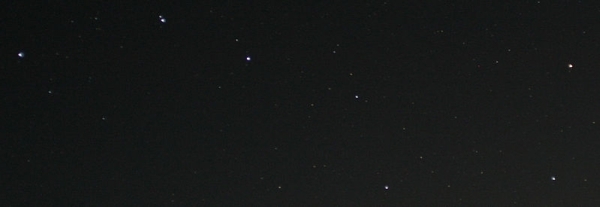¡SkyCaramba! Weekly astronomy blog for the week ending March 9, 2013
The Big Dipper is one of the most famous asterisms of all time. Cultures all over the northern hemisphere have recognized these seven stars and told stories about them. Even so, when the International Astronomical Union adopted its list of official constellations in 1922, the list didn’t include the Big Dipper. Of course, the stars are still there. They’re officially part of another constellation, the Big Bear, or Ursa Major. And since the Big Dipper is so much more easily recognized than the Big Bear, we can be sure the dipper will be part of astronomical lore for a long time.
In eastern Asia, these stars were called The Northern Dipper. English speaking people in Europe and North America recognized it as a ladle. So did slaves who escaped their masters in the southern United States heading north guided by the drinking gourd. Many European cultures recognized a cart or wagon in these stars. And still other cultures around the world have seen them as part of an animal. Most well known is the bear. The dipper’s handle is seen as a bear’s tail. People who know about bears know the tail is unusually long. To explain why, one story tells of Zeus taking a bear by the tail and putting it in the sky, stretching the appendage as he did.
Dubhe, taking its name from an Arabic word for bear, is the star at the top of the bowl opposite the handle. Merak is the star on the same side of the dipper but at the bottom. Its name refers to the bears’ loins. The two point to Polaris, the North Star. Phecda is on the bottom but on the same side as the handle. Its name means bear’s thigh. Megrez is the star where the handle and the dipper bowl meet. Its name means base of the bear’s tail.
The next three stars out to the end of the handle are Aliot, Mizar, and Alkaid. Aliot, while referring to a tail, is Arabic for a sheep’s tail. Mizar’s name means girdle. And Alkaid is named for the leader of the mourners. Its alternate name, Benetnasch means the same thing.
I need to tell you a little more about Mizar. I can’t explain why only seven stars are considered part of the Big Dipper. Mizar has a partner named Alcor. Despite stories of ancient Arabs and Native Americans testing their eyes by distinguishing the two stars, Mizar and Alcor are actually fairly easy to see as two. At various times in Japan, one could supposedly foretell his own death by whether he could see the second star. At one time, not seeing the star meant death would come within a year. At another time, actually seeing the star meant such. Mizar are sometimes called the horse and rider. One Native American story likens them to a mother carrying a papoose on her back.
Where we see two stars in Mizar and Alcor, astronomers with sophisticated equipment can detect six! The third can be seen with a telescope. The rest are known because they pull on the others gravitationally.
You can see the Big Dipper in its entirety all year if you’re north of about 40° north, unless you’re so far north you have no darkness during part of the summer. Elsewhere, you can see the Big Dipper part of the year as far south as 25° south. In mid-March, you’ll see it in the evening to the right of Polaris. By midnight, it’s at its highest in the sky on the meridian. And by sunrise, it’ll be left of Polaris. If you’re viewing from a low latitude, you may only see it all close to midnight.
http://starryskies.com/articles/2007/10/big-dip.html
http://www.astro.wisc.edu/~dolan/constellations/constellations/Ursa_Major.html
http://www.dustbunny.com/afk/constellations/bigdipper/
http://earthsky.org/favorite-star-patterns/big-and-little-dippers-highlight-northern-sky
